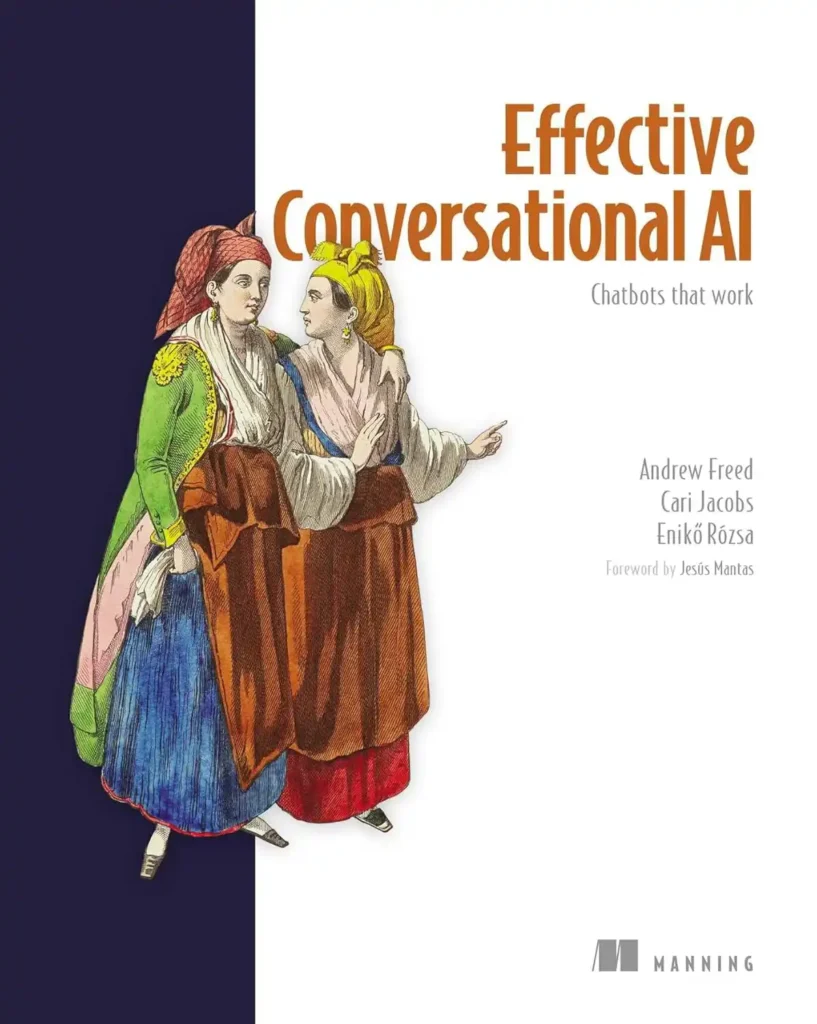
Why do so many chatbots perform well in demos but fail with real users? They greet politely and answer a few questions, but often struggle to understand intent, manage complex conversations, and keep interactions smooth.
The Effective Conversational AI Book (affiliate link) authors Andrew Freed, Cari Jacobs, and Enikő Rózsa are seasoned conversational AI developers with IBM and draw on their experience to explain how to overcome these challenges. The book uses terms like conversational AI, automated agents, and “the AI” interchangeably, all referring to the same technology for natural language interaction.
In this review, I’ve reframed the book’s four parts into four practical pillars, highlighting the authors’ key insights and methods for building smarter and more reliable chatbots.
Four Pillars of Smarter Chatbots from the Effective Conversational AI Book
The book is divided into four parts, each focused on solving key challenges in conversational AI such as weak understanding, complex flows, and poor user experience. In this review, I present those parts as four practical pillars, summarizing the main lessons and strategies the authors share to help you build more effective chatbots.
New to AI? Start with AI Fundamentals: A Beginner’s Guide to Artificial Intelligence
Pillar 1. Building a Strong Conversational AI Foundation
Effective conversational AI starts with clarity, not code. This pillar explains how conversational AI works, how to build one from scratch, and how to design for long-term improvement. Whether launching a simple FAQ bot or a more advanced process-oriented agent, a strong foundation ensures your AI is scalable, measurable, and user-focused.
The authors begin by addressing common frustrations, such as bots misunderstanding queries or giving rigid, confusing responses. They then outline a layered approach to building smarter chatbots using both traditional techniques and generative AI. A key takeaway is that AI which appears intelligent in a demo can fail in production without continuous monitoring and improvement.
Key lessons in this pillar:
- Understand what makes conversational AI effective: minimize user pain, enable task completion, and align with business goals.
- Use LLMs responsibly: they can enhance design and responses but need guardrails to prevent hallucinations.
- Start simple with FAQ bots, then scale to routing agents and task-oriented bots.
- Blend traditional and generative AI for flexible, context-aware systems.
- Build with improvement in mind: define success, form cross-functional teams, track meaningful metrics, and refine iteratively.
This pillar sets the tone for the rest of the book, focusing on user experience, solid architecture, and measurable improvement. Without it, even advanced generative models risk falling short in real-world use.
Pillar 2. Mastering User Intent and Understanding
One of the most common failures in conversational AI is when users say, “It doesn’t understand me.” This pillar tackles that issue, showing how to ensure a chatbot, whether powered by traditional classification models or advanced language models, can accurately grasp user intent.
The authors explain how to spot weak understanding through logs, metrics, and user feedback, then guide you in improving intent classification with targeted training, enhancing coverage with retrieval augmented generation (RAG), and using generative AI to create better training data. Combined, these methods help chatbots deliver clearer, more relevant responses.
Key lessons in this pillar:
- Measure real understanding with logs, metrics, and user feedback.
- Improve traditional AI through iterative training to boost accuracy, precision, recall, and F1 score, focusing on high impact areas first.
- Use RAG for long tail questions, generating answers from documents when traditional intents fall short.
- Expand intent coverage with LLMs by generating new utterances, variations, and examples, reducing manual work.
- Combine traditional handling, smart prompting, and dynamic generation for the strongest results.
This pillar focuses on closing the gap between user expectations and AI performance, ensuring bots respond with clarity, relevance, and consistency.
Pillar 3. Simplifying Complex Interactions
As chatbots gain more capabilities, they often become more complex, which can frustrate users, confuse teams, and reduce overall effectiveness. This pillar examines how to identify, manage, and reduce complexity to create smoother, more intuitive interactions for users and easier maintenance for developers.
It begins by showing how complex dialogue flows affect both user experience and business outcomes. The authors then explain how to use available user context, design for different modalities such as voice or chat, and apply generative AI to simplify both design and runtime interactions. These techniques keep bots focused on helping users complete tasks with minimal friction.
Key lessons in this pillar:
- Design with simplicity in mind: complex workflows hurt adoption and lower task completion rates. Keep paths direct, natural, and efficient.
- Use context effectively: incorporate historical and situational data, such as location or previous interactions, to personalize responses and cut unnecessary steps.
- Support multiple modalities: adapt flows for text, voice, or hybrid interfaces to meet users where they are.
- Enhance adaptiveness with RAG: combine retrieval augmented generation with dynamic flow design for better answers and easier handling of complex queries.
- Simplify with generative AI: use LLMs to generate, optimize, and simulate conversation flows, improve designs, replace rigid slot filling, and test for issues early.
This pillar promotes usability and adaptability. By reducing unnecessary complexity, chatbots become more useful, scalable, and enjoyable to use.
Pillar 4. Enhancing User Experience and Engagement
Even the most technically advanced chatbot can fail if the user experience feels cold, rigid, or confusing. This pillar focuses on reducing frustration, supporting successful self service, and managing handoffs to human agents with care, creating interactions that feel smooth, empathetic, and responsive from start to finish.
The authors examine why users opt out of chatbot interactions, whether early in the conversation or during complex moments, and how this affects containment rates and business value. They offer strategies to reduce opt outs through better greetings, clearer expectations, and friendlier messaging, as well as ways to use generative AI to improve dialogue in real time. When escalation is needed, the book explains how to summarize conversations so human agents can take over with full context.
Key lessons in this pillar:
- Reduce early opt outs with strong greetings, clear capability summaries, and a confident tone to keep users engaged.
- Keep users on track with flexible flows, proactive responses, and respectful language.
- Escalate when necessary, anticipating points where human help offers the best experience.
- Use generative AI to enhance tone in greetings, error messages, and other responses.
- Summarize conversations for human agents so they can pick up without repeating questions or losing context.
This pillar highlights that every chatbot interaction shapes the perception of your brand. Reducing friction and creating human like responsiveness leaves users feeling helped, not hindered.
Who Should Read The Effective Conversational AI Book
Effective Conversational AI book is for anyone maintaining or planning to build chatbot solutions, including business sponsors, product owners, designers, and developers. It doesn’t require a coding background, as many of the solutions can be applied using low-code or no-code tools. Whether you’re solving existing issues or starting from scratch, this book offers practical insights to help you build smarter and more effective conversational AI systems.
Final Thoughts
The Effective Conversational AI Book is a practical, experience-driven guide for building and managing chatbot systems that truly work in the real world. It tackles challenges such as weak understanding, unnecessary complexity, and poor user experience, while showing how to blend traditional techniques with large language models for stronger results.
The strategies apply across platforms, including IBM watsonx, Google Dialogflow, Amazon Lex, Rasa, and OpenAI models. Whether you’re enhancing responses with RAG, generating summaries, or refining FAQ bots, the core principles remain the same: design with the user in mind, track meaningful outcomes, and improve continuously.
For anyone serious about creating chatbots that deliver both business value and a positive, human-like user experience, The Effective Conversational AI Book provides a clear and actionable framework worth following.
Get the book here
Effective Conversational AI book by Andrew Freed, Cari Jacobs, and Enikő Rózsa is available from Manning Publications (affiliate links) and also on Amazon (affiliate links).
If you’re building or improving chatbots, this book offers a practical framework worth reading.
Disclosure: This article about Effective Conversational AI book contains affiliate links. If you purchase through them, we may earn a small commission at no extra cost to you. It supports us in creating more free content on Noro Insight.


